Overview

Title screen of Final Fantasy III (US)
Final Fantasy VI (originally known as Final Fantasy III in North America) is a role-playing game developed and published by Square. It was released on the Super Famicom on April 2, 1994. Six months later, on October 11, 1994, it was released as Final Fantasy III on the Super Nintendo Entertainment System in North America. Final Fantasy VI was later re-released on the Sony PlayStation (its first European release) and Game Boy Advance. The Playstation versions added load time pauses before each battle, but it is still a good game despite this flaw. Both of these rereleases were developed by TOSE and published by various publishers.
Final Fantasy VI is generally considered by fans and critics alike to be one of the best console role-playing games (it has a 94% rating on GameRankings), let alone Final Fantasy games, ever made. The game was met with wide critical acclaim, being praised for its varied and complex characters, interesting story, and graphical excellence.
Development
Final Fantasy VI was the first Final Fantasy game to not be directed by Final Fantasy creator Hironobu Sakaguchi, instead of being co-directed by Yoshinori Katase and Hiroyuki Ito. The composer for the game was famed Final Fantasy composer Nobuo Uematsu. Yoshitaka Amano created the character design for the game, which were then converted into sprites (taking small liberties from time to time, such as changing hair color) by the graphic design team headed by Tetsuya Takahashi (head graphic designer), Hideo Minaba (background graphics), Kazuko Shibuyo (object graphics), and Tetsuya Nomura (who designed some characters).The game also utilized the Super Nintendo's unique Mode 7 capabilities. When exploring the map, the world scrolls in a pseudo-3D fashion, common to Mode 7 style graphics.
Localization
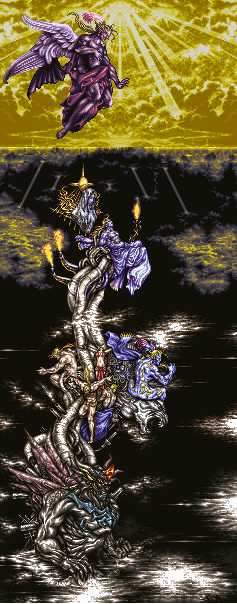
The Japanese version's final battle screens
When released in North America, Final Fantasy VI had many changes from the original version. The first and most noticeable is the name change; from Final Fantasy VI to Final Fantasy III. Despite the name change, the game is now commonly referred to as Final Fantasy VI, as to avoid confusion. There were no major gameplay changes, like previous games in the series, but much of the script was changed. The game's translator, Ted Woolsey, said that the Japanese version contained much "playfulness and sexuality" that couldn't be carried over due to Nintendo of America's strict guidelines.
As is common in games, most of the names changed, for a variety of different reasons. Some names were changed because they broke the six character limit (Stragus to Strago), while others were changed to seem more exotic (Tina to Terra). Since the game came out before the ESRB ( Entertainment Software Ratings Board) was a standard, many changes had to be made due to sexual or violent content. The text files had to be shortened because of the limited space in the cartridge. It took Ted Woolsey only 30 days to complete the translation all by himself.
Many of the sprites in the Japanese version of the game were bordering on nudity, so these were edited. The woman form of the Chadarnook was edited to cover up more of the skin, as was the Critic, Goddess, and Siren sprites. The sprites used in the final battle also differ; the Japanese version is much larger than the American version.
Other Versions

Final Fantasy VI: The Interactive CG Game
Final Fantasy VI has been re-released in various forms on a variety of systems after its original Super Famicom/SNES release. First, there was a technical demonstration based on the original Final Fantasy VI, called Final Fantasy VI: The Interactive CG Game. In the game, players controlled Terra, Locke, and Shadow in various battles by drawing patterns with a mouse, each pattern corresponding to a different move. The game was used to demonstrate the uses of SGI ( Silicon Graphics, Inc.) and a possible graphical direction for Square's next RPG. The technology was later put to use in Final Fantasy VII.
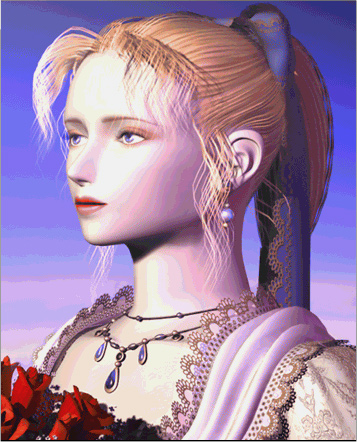
Celes Chere in a CG trailer available in the PlayStation version
Final Fantasy VI was also released three separate times for PlayStation: it was included in Final Fantasy Anthology (released on October 5, 1999) and Final Fantasy Collection (released only in Japan on March 11, 1999), and was also released as a standalone title (only in Japan and PAL regions). The game was left relatively unchanged, save for the addition of CG opening and closing cutscenes, and added load times before each of the game's many randomly triggered encounters. Other notable things included were a bestiary and artwork library that was accessible from the title screen. Various other things were added, such as new opening and closing effects to battles, the option to quicksave (although all saving still had to be initiated manually), and bug fixes although most of the bugs from the SNES version remained including the Mblock/Evade bug (as well as new bugs being created). The standalone edition of the game had a limited edition that shipped fifty-thousand copies and came with an alarm clock. Final Fantasy Anthology has an 80% rating on Metacritic and an 85% on GameRankings, gaining it the status of "generally favorable reviews."
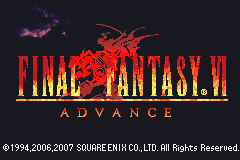
Title screen of Final Fantasy VI Advance
Final Fantasy VI Advance was released on the Game Boy Advance on November 30, 2006 in Japan, February 5, 2007 in North America, and June 29, 2007 in Europe. This version is more extensively changed than the PlayStation ports, but without the load times before each of the game's many randomly triggered encounters. New gameplay features, redone graphics, and a retranslated script are among the most notable things included. Four new Espers were included in the game (Leviathan, Gilgamesh, Cactuar, and Diabolos), as well as two new locations: the Dragons' Den (which included a new boss, the Kaiser Dragon) and the Soul Shrine (in which players could battle enemies continuously). Three new spells are included in the game, and bugs from the original are fixed. A bestiary and music player are also included in the game. In addition, the boxart and game-related art has been redone as well, again by Yoshitaka Amano. One scene, in which Celes is beaten, has been removed from the game, presumably due to events in Japan at the time of release. The game was relatively well-received from both critics and fans alike; it holds a 92% average rating on Metacritic and a 91% average on GameRankings.
Gameplay

An example of the overworld
The gameplay of Final Fantasy VI is similar to that of its predecessors and of other 16-bit Japanese RPGs. Player characters move about the game's fictional setting, completing a story-fueled series of objectives: reaching a certain location, defeating a certain enemy, retrieving a certain item, solving a puzzle, figuring out what to do next, etc. The gameplay is often broken up by story and dialogue sequences, which advance the story through generally non-interactive conversations and events. Over the course of the game, the player-controlled party grows to include a handful of unique characters; this group acts as the primary perspective from which players view the unfolding plot. As they battle enemies (which are encountered at random and are unavoidable) these player characters gain EXP (experience points), which allow them to gain levels. Every time a character gains a level, his or her stats (attributes upon which combat capability depends) are raised, allowing the character to fight more powerful enemies more easily.
There are four main screens in the game.
In the overworld screen, the player party traverses an expansive land, moving between various locales (towns and dungeons). More parts of the overworld and more locales become accessible as the player makes progress through the game. The party is susceptible to randomly triggered battles in the overworld.
Towns and dungeons are accessible from the overworld. In this screen, the player party moves about smaller-scale areas, interacting with NPCs and environmental objects. Towns generally include shops and inns, whose goods and services are bought with GP (currency). Towns are populated by numerous NPCs, with which the player can converse. Dungeons are more dangerous, as the party is vulnerable to enemy attacks while exploring them, due to randomly triggered encounters, and no shops or inns are found within. (Although Tents can be used at save points to replenish the party's health and magic, serving the same purpose as an inn.) Often contained in a dungeon is one of many powerful boss enemies, most of which must be fought in the course of the game. Dungeons are usually larger and more complexly designed than towns. Towns and dungeons are the primary settings for cutscenes and plot events.
In the battle screen, the player controls the party as it fights against an enemy or enemies. The player enters the battle screen when a random or scripted battle is commenced, and exits by winning, fleeing, or losing the battle. (Losing a battle results in a game over, meaning that all the player's progress since their last save point is lost, and the player is sent back to the title screen without even being offered a chance to try that battle again). In battle, the player does not directly control character movement; instead, the player selects battle commands from menus unique to the individual party members.
The menu screen is accessible from the overworld and town/dungeon screens. Here, the player can use items, manage party members' equipment and abilities, view their stats, change game settings, and save their progress. (which has to be done manually)
Combat

A typical battle screen.
Final Fantasy VI's battles (which are most often random) utilize the Active Time Battle system first implemented in Final Fantasy IV. Each character has his or her own action gauge, which fills up at a rate dependent on the character's speed stat. When the gauge is full, the character can perform actions chosen from his or her command list. Such actions include performing a basic attack, casting a magic spell, using an item, and drawing upon the unique ability of the character.
Magic, as in all Final Fantasy games, can be used for a range of purposes. Primarily, spells are used to inflict damage, bestow status conditions (both positive and negative), and heal. To cast a spell, a character must use MP, which can be restored similarly to HP. If a character's current MP is lower than the MP cost of a spell, he or she will be unable to cast it. MP, like HP, is a stat; as it rises, the character's maximum MP count will rise.
As in many Final Fantasy games, the combat screen is separated into one large rectangle on top, in which all the action takes place, and one smaller one at the bottom of the screen, in which the player inputs commands. Certain non-interactive cutscenes also take place on the combat screen, with characters displayed as battle sprites.
When the party wins a battle, it gains EXP, GP, and (sometimes) AP (see the "Equipment" section below). Defeated enemies sometimes also drop items or equipment.
Equipment

Browsing through items at an item store
There is a lot of equipment in the game, providing for great lengths of customization. The right hand, left hand, head, and body can all be customized with a wide variety of weapons and armor. Weapons determine the nature of characters' physical attacks, while shields and armor boost their stats (primarily defense and magic defense). Generally, one hand holds a weapon, one hand holds a shield, the head holds headgear, and the body holds body armor. However, the Genji Glove and Gauntlet relics (see below) allow characters to break the rules regarding weapon-equipping.
Relics are items that have effects less traditional than those of weapons and armor. Two can be equipped at once by each character, allowing them to bestow myriad potential bonus combinations. Examples of relics include the Sniper Sight (which ensures a 100% hit rate of basic attacks), the Black Belt (which grants a 50% chance of counterattacking against enemies' physical strikes), and the Alarm Earring (which prevents back attacks and pincer attacks). Relics can protect against various status conditions, bestow positive status conditions, change the nature of attacks or abilities, and boost stats. There are also relics that offer out-of-battle bonuses; for example, the Sprint Shoes double walking speed in towns and dungeons.
Espers add a deep customization element to the game's magic system. Although they are not introduced particularly early in the game, they are an essential part of the game's character customization. Espers collected in their Magicite forms are the primary means by which characters learn magic spells. Each one has a unique set of spells, and each spell has a corresponding rate multiplier (a spell's multiplier usually varies between the different Espers that teach it). When a character has equipped an Esper (each character can equip one at a time), battling will further his or her learning of the Esper's spells: the number of AP (ability points) earned at the end of battle is multiplied by each spell's rate multiplier and added to the spell's growth percentage, which represents the character's learning progress. When the character's growth percentage for a spell reaches 100, he or she learns it. When the Esper is unequipped from the character, all its growth percentages (and availability of learned spells) remain; even if a percentage is lower than 100, the character can later continue adding to it by equipping another Esper (or the same Esper) with the given spell.
Espers also feature as the game's summons. Each equipped Esper can be summoned once per battle to perform its unique spell; these summon spells are generally more powerful than most commonly learned magic. No AP growth is needed to perform summons.
It should be noted that, due to the workings of the Magicite system, every character in the game (save Gogo and Umaro, who cannot equip Espers) can learn every spell, even though Terra and Celes are the only ones who can learn magic through leveling.
Plot
The game's story begins 1,000 years in the past during the War of the Magi. Espers had power, and men wanted that. What was necessary to obtain it was to kill the Esper and collect the remains, called Magicite. It was total war, very nearly apocalyptic in its scope. Society needed 1,000 years to return to a semblance of what it was beforehand. With the Espers now in self-imposed exile, the war came to a close.

Terra, Biggs, and Wedge search for an Esper during the opening credits.
The game opens with Terra, an amnesiac girl aiding the Empire in searching the village of Narshe for an Esper (specifically, the Esper 'Tritoch'). After dispatching a few guards, the group comes upon the Esper. The guards approach it slowly, but Terra reacts strangely to it, killing the guards. When she awakes, she is under the care of an old man who claims to be part of a rebel group known as the Returners. He explains that Terra has been controlled by a Slave Crown, forcing her to do the Empire's bidding. He agrees to assist her, when all of the sudden, Imperial Soldiers come knocking at the door. The old man quickly tells Terra to flee, showing her the back way.
The player is then introduced to Locke Cole, a cocky, self-assured thief (although he prefers 'treasure hunter'). He aids Terra in the fight against the Imperial Soldiers, as well as enlisting the help of several Moogles. After the battle, Locke vows to protect Terra no matter the cost, and proceeds to do so at the best of his ability. After assisting in protecting Terra from Imperial Soldiers, he is tasked with leading Terra to the hideout of the Returners.
Along the way, the small party stops at Figaro Castle. There, they are introduced to the "ladies' man" Edgar Roni Figaro. Edgar is charming, and attempts in sweet-talking Terra, although she is unlike other women that Edgar has courted, as she seems incapable of love. Edgar is seemingly an ally with the Empire, but in reality, he is an essential leader of the Returners. After being introduced to Edgar, Kefka comes in search of Terra. Kefka lies that the girl is "of no importance" to the Empire, but everyone present sees past Kefka's ploy.
Edgar bravely lies, saying that Terra is not in the castle. In response, Kefka sets his castle on fire. As he is laughing manically, the party manages to escape, and then the castle dives beneath the sand (moving over to an area near Kohlingen). Kefka is humiliated and outraged, especially after the party manages to dispatch his Magitek soldiers. The party makes their way to Mt. Koltz, where Sabin Rene Figaro is introduced. Vargas (Duncan's son) attacks the party, due to the fact that he believes his father will give the fighting dojo he owns to Sabin. A brief scene plays out in which Sabin disposes of Vargas, who was intent on murdering Sabin in order to gain the dojo. After a brief reuniting "ceremony," the party sets out once again for the Returners' headquarters.

The Returners' headquarters
Upon reaching the Returners' headquarters, the leader, Banon, requests Terra's assistance in dethroning the Empire. The player is given the choice of whether or not to accept the offer, but either way, Terra will end up aiding the Returners. After Terra accepts, a battle plan is laid out. Unfortunately, a Returner bursts and announces that the town of South Figaro has been attacked by Imperial forces. Locke goes to investigate, while the rest of the party escapes on the Lethe River. After a battle with Ultros, however, the party is separated from Sabin, who is thrown off to an unknown destination.
The player then has the choice to choose between Locke's scenario, Sabin's scenario, or Edgar and Terra's scenario. All must be chosen eventually, but the order is up to the player. In Edgar and Terra's scenario, the party merely fights their way through several enemies and eventually makes it to Narshe.
In Locke's scenario, Locke is in South Figaro. The town is crawling with Imperial Soldiers, so Locke steals some clothes to impersonate a merchant. He uses this disguise to infiltrate one of the buildings that the Imperial Soldiers are using as headquarters. Here, he steals some clothes from an Imperial Soldier, and traverses throughout the house. In the back, he finds Celes, a former general for the Empire who has been infused with artificial magical abilities. She has been labeled as a traitor, although trusting her throughout the game is always risky, and is referenced constantly. She agrees to join the Returners. The two manage to make it back to Narshe as well.
Sabin awakes near a house somewhere in the overworld. He meets Shadow, a ninja, whom is willing to accompany him, for a fee. They travel to the city of Doma, where they encounter an Imperial force. Kefka is there, and he impatiently wants to poison Doma's water supply as to speed up the occupation process. After General Leo leaves, Kefka follows through with his plan, despite direct orders from Leo not to go through with it. Everyone in the city except for Cyan dies. Cyan angrily leaves and begins to blindly attack at the enemies, hitting Sabin in the process. He apologizes, and the team agrees that they are there for the same reason; to dispose of the Empire. They proceed to escape by using the Magitek Armor that is in the camp (it is notable that this is the last time that the player can use Magitek Armor). After traveling for a while, the party comes upon a forest.
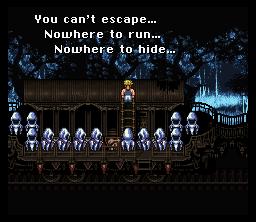
Sabin and Cyan try to escape the Phantom Train
In the forest, they find a train. Hesitantly, they aboard the train (despite the warnings from Cyan). Once onboard, it is revealed that the train is the Phantom Train; it passages the dead into their next life. After much battling, the party manages to make it off the train. Cyan then witnesses his wife and son boarding. Sadly, he cries for them and blames himself for what happened in Doma. After making it to the small town of Mobliz, the party is introduced to a young boy known as Gau. He is rather insane, as he lives in the Veldt, a strip of land inhabited only by feral animals. The party befriends him, and he gives them his "treasure," an underwater breathing apparatus. They use this to travel underwater. The party emerges in the town of Nikeah. In Nikeah, there is a port, which can take the party to Narshe. They board the boat, and manage to make it back to Narshe.

The exterior of Figaro Castle
After reuniting in Narshe--along with new members Cyan, Gau, and Celes--the group prepares to defend the frozen Esper encountered in the beginning of the game. After holding off the Imperial forces long enough, however, Terra transforms into a strange pink form, and flies off. The party attempts to track her down, eventually finding her in the town of Zozo.
Here, she is being cared for by the Esper Ramuh, who tells them about the Espers, Magicite, and then implores them to infiltrate the Magitek Research Facility, where his friends are being tortured and drained of their power. To reach the facility, however, an airship is required. Setzer, a renowned thief, owns the only airship in the world. He has threatened to kidnap Maria, the star of an opera. Celes has an uncanny resemblance to Maria, so she poses as Maria.
Setzer holds up to his promise and kidnaps "Maria," but the party comes along as well. Setzer finds this rather humorous and agrees to assist the party. After retrieving the Espers, including one named Maduin (who is Terra's father), the party returns to Zozo. The power of the Magicite that the Espers have transformed into shows Terra her past. Her mother stumbled into the Esper world long ago. One Esper took pity on her, Maduin, and the two fell in love. They had a child, Terra. Soon, however, Emperor Gestahl, Kefka, and the Imperial Forces make it into the Esper world. To wipe them out, the Espers do a magical spell to cleanse the world of any humans. Unfortunately, Terra and her mother are taken out as well. Emperor Gestahl notices Terra, and adopts her to be his warrior. After this flashback, Terra gains the ability to switch between her Esper and human forms.
After reuniting with Terra, the Returners decide that it is time for a final attack against the Empire. The Returners request Terra's assistance in asking the Espers for help. Terra does so, but the human world causes the Espers to attack violently, similarly to when Terra first transformed into an Esper. The Espers completely annihilate the capital city of the Empire, Vector. Emperor Gestahl is astounded at the destruction caused by the Espers, so he requests an alliance between the Returners and the Empire. Locke and Terra are grouped with Shadow, Celes, and General Leo as they search for the Espers to lay out the terms of peace.

Emperor Gestahl makes peace with the Returners
Upon arriving at the town of Thamasa, the party finds that no one has any knowledge of Espers or magic, and the village's inhabitants act very hostile towards the party. The party discovers an elderly mage, Strago, who has knowledge of the Espers and magic (although he refuses to admit it). He eventually befriends the party and reveals that the village's inhabitants are all descendants of mages that fought in the War of the Magi. He recommends that the party go get some sleep. During the night, he rushes in shouting that one of the houses is on fire, and his granddaughter, Relm, is trapped inside. The party manages to rescue her, and the two join the party to search for the Espers. Soon enough, they find the Espers, and the peace terms are laid out by General Leo (who is unaware of the evil plans of Gestahl and Kefka). This peaceful gathering is quickly interrupted by Kefka. He absorbs the power from all of the Espers, and after resistance from Leo, promptly murders him.
The Returners are reunited, and by now, it is clear what Kefka and Emperor Gestahl's evil intentions are. They plan to resurrect the Floating Continent. To do so, they must go into the now open Esper world and collect the remains of the Warring Triad. They easily do so, and the island that the Esper world is located on rises into the sky: the Floating Continent.
Three statues are in place on the Floating Continent that provide perfect balance for the entire world. If moved even the slightest, the world could be reshaped and destroyed. Obviously, Kefka and Gestahl have evil intent. After fighting their way to Kefka and Gestahl, the party is all knocked unconscious except for Celes (whose allegiance is shaky). Kefka offers her a sword and commands her to kill the party. She refuses, and instead stabs Kefka. Kefka is angered by this, and he begins to use the magic that the statues are granting him. Gestahl is opposed to this, but is quickly disposed of by Kefka. Kefka then moves all of the statues around, causing what is best described as the end of the world.
Fortunately, the game does not end there. The second part of the game, the World of Ruin, begins with Celes awaking from a year-long coma. After awakening, she finds herself on an island under the care of Cid, who has become a fatherly figure to her. Cid reveals to Celes that he has become gravely ill and at that moment, the game leaves his fate in the player's hands. The player can choose to have Celes nurse Cid back to good health by catching and feeding him "yummy" or regular fish. Conversely, Cid can die by feeding him rotten fish or if Celes does not tend to his illness. If Cid dies, Celes will find a raft that he built so she could sail to freedom, but not before attempting suicide (which is referenced more in the Japanese version of the game). If Cid lives, he will show Celes the raft he was building and give it to her so she can leave the island. Regardless of whether Cid lives or dies, Celes will eventually set out to find all of her friends.
The World of Ruin is mostly non-linear (as opposed to the World of Balance), and after acquiring a certain amount of required party members, the player can proceed to Kefka's Tower, where he rules with an iron fist. Each character has a unique story during the World of Ruin, and while some are optional, it is definitely interesting to see where they have gone. In addition, each character has an optional side-quest that maximizes their power. Optional characters Umaro and Gogo and be obtained during the World of Ruin as well. After destroying the three statues housed inside, the party makes their way to Kefka. He has drained the Warring Triad of their power, so now he has godlike strength. He launches into a monologue, enraged that the world can still cling to hope, citing the World of Ruin as a reason why the party should just give up hope. After each of the party's members gives a personal example of why he or she still has hope, the final battle begins.
After the destruction of Kefka, it is revealed that all the Magicite that was in him helped keep magic in power. Destroying Kefka means the end of magic, meaning the potential destruction of Terra. As Terra helps the party escape in her Esper form, her father comes and tells her that if she can cling onto her human side, she may survive. The airship Falcon manages to catch her as she falls, and she survives: a human. The world is saved, Kefka has been defeated. A montage of clips from various portions of the world plays, showing how the citizens are rebuilding the world after the horror of Kefka's reign.

Terra, Biggs, and Wedge search for an Esper during the opening credits.
The game opens with Terra, an amnesiac girl aiding the Empire in searching the village of Narshe for an Esper (specifically, the Esper 'Tritoch'). After dispatching a few guards, the group comes upon the Esper. The guards approach it slowly, but Terra reacts strangely to it, killing the guards. When she awakes, she is under the care of an old man who claims to be part of a rebel group known as the Returners. He explains that Terra has been controlled by a Slave Crown, forcing her to do the Empire's bidding. He agrees to assist her, when all of the sudden, Imperial Soldiers come knocking at the door. The old man quickly tells Terra to flee, showing her the back way.
The player is then introduced to Locke Cole, a cocky, self-assured thief (although he prefers 'treasure hunter'). He aids Terra in the fight against the Imperial Soldiers, as well as enlisting the help of several Moogles. After the battle, Locke vows to protect Terra no matter the cost, and proceeds to do so at the best of his ability. After assisting in protecting Terra from Imperial Soldiers, he is tasked with leading Terra to the hideout of the Returners.
Along the way, the small party stops at Figaro Castle. There, they are introduced to the "ladies' man" Edgar Roni Figaro. Edgar is charming, and attempts in sweet-talking Terra, although she is unlike other women that Edgar has courted, as she seems incapable of love. Edgar is seemingly an ally with the Empire, but in reality, he is an essential leader of the Returners. After being introduced to Edgar, Kefka comes in search of Terra. Kefka lies that the girl is "of no importance" to the Empire, but everyone present sees past Kefka's ploy.
Edgar bravely lies, saying that Terra is not in the castle. In response, Kefka sets his castle on fire. As he is laughing manically, the party manages to escape, and then the castle dives beneath the sand (moving over to an area near Kohlingen). Kefka is humiliated and outraged, especially after the party manages to dispatch his Magitek soldiers. The party makes their way to Mt. Koltz, where Sabin Rene Figaro is introduced. Vargas (Duncan's son) attacks the party, due to the fact that he believes his father will give the fighting dojo he owns to Sabin. A brief scene plays out in which Sabin disposes of Vargas, who was intent on murdering Sabin in order to gain the dojo. After a brief reuniting "ceremony," the party sets out once again for the Returners' headquarters.

The Returners' headquarters
Upon reaching the Returners' headquarters, the leader, Banon, requests Terra's assistance in dethroning the Empire. The player is given the choice of whether or not to accept the offer, but either way, Terra will end up aiding the Returners. After Terra accepts, a battle plan is laid out. Unfortunately, a Returner bursts and announces that the town of South Figaro has been attacked by Imperial forces. Locke goes to investigate, while the rest of the party escapes on the Lethe River. After a battle with Ultros, however, the party is separated from Sabin, who is thrown off to an unknown destination.
The player then has the choice to choose between Locke's scenario, Sabin's scenario, or Edgar and Terra's scenario. All must be chosen eventually, but the order is up to the player. In Edgar and Terra's scenario, the party merely fights their way through several enemies and eventually makes it to Narshe.
In Locke's scenario, Locke is in South Figaro. The town is crawling with Imperial Soldiers, so Locke steals some clothes to impersonate a merchant. He uses this disguise to infiltrate one of the buildings that the Imperial Soldiers are using as headquarters. Here, he steals some clothes from an Imperial Soldier, and traverses throughout the house. In the back, he finds Celes, a former general for the Empire who has been infused with artificial magical abilities. She has been labeled as a traitor, although trusting her throughout the game is always risky, and is referenced constantly. She agrees to join the Returners. The two manage to make it back to Narshe as well.
Sabin awakes near a house somewhere in the overworld. He meets Shadow, a ninja, whom is willing to accompany him, for a fee. They travel to the city of Doma, where they encounter an Imperial force. Kefka is there, and he impatiently wants to poison Doma's water supply as to speed up the occupation process. After General Leo leaves, Kefka follows through with his plan, despite direct orders from Leo not to go through with it. Everyone in the city except for Cyan dies. Cyan angrily leaves and begins to blindly attack at the enemies, hitting Sabin in the process. He apologizes, and the team agrees that they are there for the same reason; to dispose of the Empire. They proceed to escape by using the Magitek Armor that is in the camp (it is notable that this is the last time that the player can use Magitek Armor). After traveling for a while, the party comes upon a forest.

Sabin and Cyan try to escape the Phantom Train
In the forest, they find a train. Hesitantly, they aboard the train (despite the warnings from Cyan). Once onboard, it is revealed that the train is the Phantom Train; it passages the dead into their next life. After much battling, the party manages to make it off the train. Cyan then witnesses his wife and son boarding. Sadly, he cries for them and blames himself for what happened in Doma. After making it to the small town of Mobliz, the party is introduced to a young boy known as Gau. He is rather insane, as he lives in the Veldt, a strip of land inhabited only by feral animals. The party befriends him, and he gives them his "treasure," an underwater breathing apparatus. They use this to travel underwater. The party emerges in the town of Nikeah. In Nikeah, there is a port, which can take the party to Narshe. They board the boat, and manage to make it back to Narshe.

The exterior of Figaro Castle
After reuniting in Narshe--along with new members Cyan, Gau, and Celes--the group prepares to defend the frozen Esper encountered in the beginning of the game. After holding off the Imperial forces long enough, however, Terra transforms into a strange pink form, and flies off. The party attempts to track her down, eventually finding her in the town of Zozo.
Here, she is being cared for by the Esper Ramuh, who tells them about the Espers, Magicite, and then implores them to infiltrate the Magitek Research Facility, where his friends are being tortured and drained of their power. To reach the facility, however, an airship is required. Setzer, a renowned thief, owns the only airship in the world. He has threatened to kidnap Maria, the star of an opera. Celes has an uncanny resemblance to Maria, so she poses as Maria.
Setzer holds up to his promise and kidnaps "Maria," but the party comes along as well. Setzer finds this rather humorous and agrees to assist the party. After retrieving the Espers, including one named Maduin (who is Terra's father), the party returns to Zozo. The power of the Magicite that the Espers have transformed into shows Terra her past. Her mother stumbled into the Esper world long ago. One Esper took pity on her, Maduin, and the two fell in love. They had a child, Terra. Soon, however, Emperor Gestahl, Kefka, and the Imperial Forces make it into the Esper world. To wipe them out, the Espers do a magical spell to cleanse the world of any humans. Unfortunately, Terra and her mother are taken out as well. Emperor Gestahl notices Terra, and adopts her to be his warrior. After this flashback, Terra gains the ability to switch between her Esper and human forms.
After reuniting with Terra, the Returners decide that it is time for a final attack against the Empire. The Returners request Terra's assistance in asking the Espers for help. Terra does so, but the human world causes the Espers to attack violently, similarly to when Terra first transformed into an Esper. The Espers completely annihilate the capital city of the Empire, Vector. Emperor Gestahl is astounded at the destruction caused by the Espers, so he requests an alliance between the Returners and the Empire. Locke and Terra are grouped with Shadow, Celes, and General Leo as they search for the Espers to lay out the terms of peace.

Emperor Gestahl makes peace with the Returners
Upon arriving at the town of Thamasa, the party finds that no one has any knowledge of Espers or magic, and the village's inhabitants act very hostile towards the party. The party discovers an elderly mage, Strago, who has knowledge of the Espers and magic (although he refuses to admit it). He eventually befriends the party and reveals that the village's inhabitants are all descendants of mages that fought in the War of the Magi. He recommends that the party go get some sleep. During the night, he rushes in shouting that one of the houses is on fire, and his granddaughter, Relm, is trapped inside. The party manages to rescue her, and the two join the party to search for the Espers. Soon enough, they find the Espers, and the peace terms are laid out by General Leo (who is unaware of the evil plans of Gestahl and Kefka). This peaceful gathering is quickly interrupted by Kefka. He absorbs the power from all of the Espers, and after resistance from Leo, promptly murders him.
The Returners are reunited, and by now, it is clear what Kefka and Emperor Gestahl's evil intentions are. They plan to resurrect the Floating Continent. To do so, they must go into the now open Esper world and collect the remains of the Warring Triad. They easily do so, and the island that the Esper world is located on rises into the sky: the Floating Continent.
Three statues are in place on the Floating Continent that provide perfect balance for the entire world. If moved even the slightest, the world could be reshaped and destroyed. Obviously, Kefka and Gestahl have evil intent. After fighting their way to Kefka and Gestahl, the party is all knocked unconscious except for Celes (whose allegiance is shaky). Kefka offers her a sword and commands her to kill the party. She refuses, and instead stabs Kefka. Kefka is angered by this, and he begins to use the magic that the statues are granting him. Gestahl is opposed to this, but is quickly disposed of by Kefka. Kefka then moves all of the statues around, causing what is best described as the end of the world.
Fortunately, the game does not end there. The second part of the game, the World of Ruin, begins with Celes awaking from a year-long coma. After awakening, she finds herself on an island under the care of Cid, who has become a fatherly figure to her. Cid reveals to Celes that he has become gravely ill and at that moment, the game leaves his fate in the player's hands. The player can choose to have Celes nurse Cid back to good health by catching and feeding him "yummy" or regular fish. Conversely, Cid can die by feeding him rotten fish or if Celes does not tend to his illness. If Cid dies, Celes will find a raft that he built so she could sail to freedom, but not before attempting suicide (which is referenced more in the Japanese version of the game). If Cid lives, he will show Celes the raft he was building and give it to her so she can leave the island. Regardless of whether Cid lives or dies, Celes will eventually set out to find all of her friends.
The World of Ruin is mostly non-linear (as opposed to the World of Balance), and after acquiring a certain amount of required party members, the player can proceed to Kefka's Tower, where he rules with an iron fist. Each character has a unique story during the World of Ruin, and while some are optional, it is definitely interesting to see where they have gone. In addition, each character has an optional side-quest that maximizes their power. Optional characters Umaro and Gogo and be obtained during the World of Ruin as well. After destroying the three statues housed inside, the party makes their way to Kefka. He has drained the Warring Triad of their power, so now he has godlike strength. He launches into a monologue, enraged that the world can still cling to hope, citing the World of Ruin as a reason why the party should just give up hope. After each of the party's members gives a personal example of why he or she still has hope, the final battle begins.
After the destruction of Kefka, it is revealed that all the Magicite that was in him helped keep magic in power. Destroying Kefka means the end of magic, meaning the potential destruction of Terra. As Terra helps the party escape in her Esper form, her father comes and tells her that if she can cling onto her human side, she may survive. The airship Falcon manages to catch her as she falls, and she survives: a human. The world is saved, Kefka has been defeated. A montage of clips from various portions of the world plays, showing how the citizens are rebuilding the world after the horror of Kefka's reign.
Playable Characters

Fourteen characters are fully playable in the game. They range from a little girl with a talent for painting to a full-grown yeti. While the plot initially forces the player to use certain characters at certain times, later sections of the game leave party creation largely to the player. Dialogue at certain plot points is entirely dependent on the player's chosen party composition. In this way, the game takes a significant step towards a more rewarding role-playing experience.
Each character has a back story significant to his or her development, if not to the main plot. The depth of the cast is commonly praised as a highlight of the game, and some character subplots are arguably more compelling than the main storyline. In the World of Ruin section, most characters have optional side-stories that delve into their histories and their psyches more deeply than the main story. For instance, in Cyan's side-quest, the party explores his subconsciousness, eventually freeing him from a captor demon. He meets the ghosts of his wife and child, and they encourage him to not hold himself responsible for the events that transpired in Doma. Each of these side-quests addresses a previously touched-upon attribute (personality trait, life event, etc.) of its central character.
Terra Branford
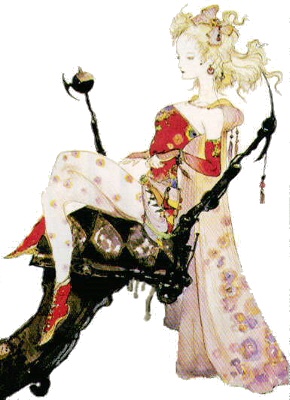
Terra (Tina in the Japanese version) is a girl with mysterious origins whom the player are first introduced to in the beginning of the game. She is with a group of Imperial Soldiers as they search the town of Narshe for an Esper, which appears to have been recently uncovered in the mines of Narshe. The soldiers Terra is with discuss where she came from and one mentions that she makes him uncomfortable. The soldiers (and Terra) are in a powerful suit known as Magitek Armor that gives the wearer incredible defense, strength, stamina, health, and even powerful magic attacks. After the group finds the Esper, Terra reacts strangely to it and the group of soldiers with her disappear.
Later in the game, it is revealed that Terra is the daughter of an Esper named Maduin and a human mother named Madonna. Madonna somehow ended up in the Esper realm and Maduin fell in love with her. When Imperial Soldiers attempt to invade the Esper realm, Madonna and her baby girl are sucked back into the human realm, where Terra is raised by Emperor Gestahl. She is said to have destroyed fifty Imperial Soldiers in one exercise, so Gestahl controls her through an item called the Slave Crown (which is later removed by The Returners).
In the World of Ruin, Terra is found in the town of Mobliz, caring for all of the children who lost their parents when the Light of Judgment obliterated their town. Terra fears that she isn't powerful enough anymore, but when she annihilates a monster that comes to destroy the children, she gains courage and encourages the children to live for hope. She then joins the party to keep Kefka from causing the world anymore pain.
At one point in the game, Terra learns her special ability: Morph. This allows her to transform into an Esper and boosts her magic and physical attack. Her Esper form is a glowing pink figure with long hair. She can switch back and forth between it.
Locke Cole
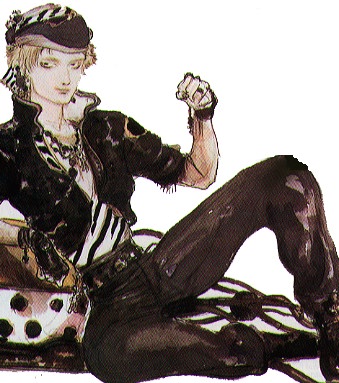
Locke (Lock in the Japanese version) is a young thief. However, whenever he is referred to as a thief--be it by a close friend or a stranger--he becomes enraged and claims that he is a 'treasure hunter.' His special ability is Steal, which allows him to take items from certain enemies. A Relic, the Thief Glove, can turn this attack into Capture, in which Locke attacks and steals at the same time. In the beginning of the game, Locke vows to protect both Terra and Celes, and attempts to keep that promise at the best of his ability.
Locke was in love with a girl from Kohlingen named Rachel, who normally accompanied him on his treasure hunts. On one hunt, Rachel fell and suffered an injury that caused amnesia. She forgot that she loved Locke, but he stays anyway. He is eventually too heartbroken to stay any longer, so he leaves. During his absence, the Empire attacks, and Rachel is killed. Her father says that her final words were Locke's name. Locke is so hard on himself that he searches far and wide for a way to bring her back to life. He finds a Magicite known as Phoenix that is supposed to heal people from the dead. Since it is damaged, the effects are temporary, but Rachel tells Locke not to be too hard on himself, and that she loves him.
Cyan Garamonde

Cyan (Cayenne in the Japanese version) is a loyal servant of the king of Doma. Cyan's special ability is SwdTech (short for 'Sword Technique'), a powerful attack that has eight levels (that must be upgraded by doing various things). The eight levels are selected via a time bar that slowly goes across the numbers. The SwdTech attacks do a variety of things, from multiple hits with Cyan's sword, to a one hit kill. Cyan typically speaks in Old English, saying things such as "thou art" or "sayeth." This trait is poked fun at constantly throughout the game.
When Kefka poisons Doma's water supply, everyone close to Cyan perishes (including his wife, Elaine, and his son, Owain). Angry at the Empire, he joins the Returners, where he later meets Gau, his best friend. In the World of Ruin, Cyan takes pity on a girl whose boyfriend isn't responding to her letters (due to his death), so he lives on top of Mount Zozo, writing letters to her.
Shadow
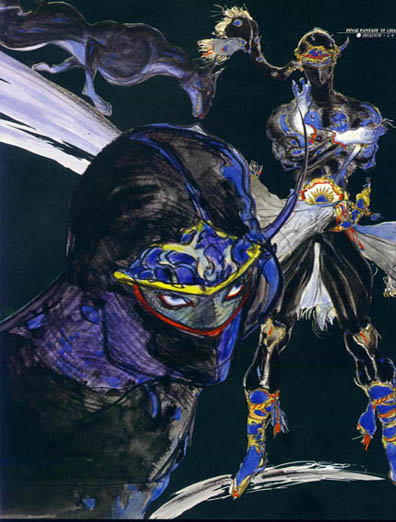
Shadow (real name Clyde) is a mysterious mercenary and assassin who would supposedly "slit his mama's throat for a nickel." He appears frequently throughout the game, and plays an important role during the climax of the game. He is always accompanied by his dog, Interceptor, who is a "merciless killer" as well (although Interceptor takes a liking to Relm). Shadow's special attack is Throw, in which he can throw a wide variety of items at the enemy for varying amounts of damage. Occasionally, Interceptor will also counterattack the enemy.
Shadow appears a few times during the first half of the game, sometimes offering services (for a fee of course). During the climax, he stays behind to help save the world, and if the player stays with him, Shadow can be found in the Cave in the Veldt, where he will join the party permanently.
A little can be found out about Shadow through dream sequences by sleeping with him in the party at an Inn. He was originally a thief named Clyde, who traveled with friend and fellow thief Baram. During a heist of one million GP, Baram gets injured and requests that Clyde kills him. Clyde runs, leaving him to an uncertain fate. He them settles down in Thamasa with a woman named Madonna, where he has a daughter (hinted to be Relm). He eventually leaves and adopts the name Shadow.
Edgar Roni Figaro
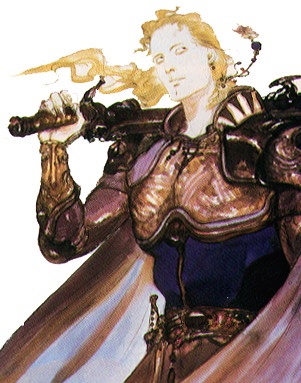
Edgar is the king of Figaro and an important member of the Returners. He likes to think of himself as a lady's man, but most of the time he comes across as being more immature than actually having a chance with women. He is the older brother of Sabin. Edgar's special ability is Tools, which allows him to use Tools found in the adventure, such as a Drill that causes an amount of damage, or a Debilitator which causes a certain magical weakness in the enemy.
When Edgar's father died, neither Sabin nor Edgar wanted to inherit the crown, so they decided to flip for it. In one of the most famous scenes in the game, Edgar flips a coin, and it is decided that he will inherit the crown. Later in the game (when Celes uses the same coin to trick Setzer into letting the party use his airship), it is revealed that he nobly used a double-sided coin so that his brother wouldn't have to rule Figaro.
In the World of Ruin, Edgar disguises himself as a thief named Gerad, and keeps the disguise until he breaks into Figaro Castle. He then reveals that he is Edgar, and fights alongside the party.
Sabin Rene Figaro
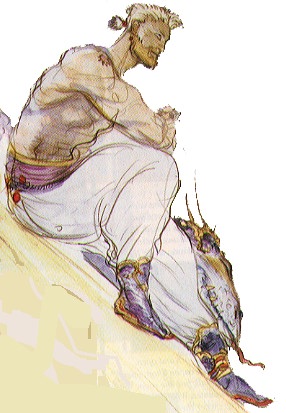
Sabin (Mash in the Japanese version) is the aforementioned younger brother of Edgar Roni Figaro. He left his inheritance to the throne to train in martial arts under a man named Duncan. Sabin's special ability is Blitz. When selected, a control code must be inputted to do a certain attack. For example right, left, right would be the control code for the move Pummel. Sabin can learn more Blitzes throughout the game, which are increasingly complex.
Sabin wins the coin toss with Edgar (the one that Edgar rigged with a double-sided coin), so he leaves his inheritance and trains under a world famous Duncan Harcourt. Duncan's son, Vargas, becomes jealous when he realizes that Sabin is superior in martial arts, and that Duncan might leave the dojo to him. Vargas attempts to murder Sabin, and then escapes to Mount Koltz, where he is defeated by Sabin. He then proceeds to reunite with Edgar, and join the party.
In the World of Ruin, Sabin is found in Tzen, holding up a building to keep the child inside from burning alive. After rescuing the child from inside, Sabin will join the party. However, if the time runs out, then Sabin is permanently dead.
Celes Chere
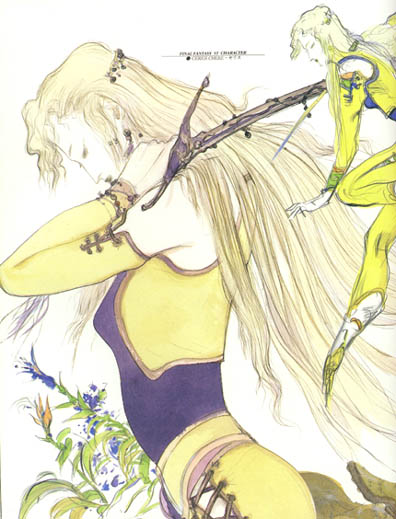
Celes is a Magitek Knight, in that she is genetically fused with magic from birth. Her special ability, Runic, allows her to absorb the next magic attack and turn it into magic points. She is one of the only other playable characters that can learn traditional magic without the aid of Espers.
Celes is one of two Imperial Generals (the other being Leo). She is accused of treason, and then tortured. After being rescued by Locke, she decides to join the Returners. Throughout the game, her loyalty is questioned constantly, but it remains true that she is on the same side with the Returners. She proves this when Kefka gives her a sword to attack the party with, but instead she attacks Kefka.
During the World of Ruin, she awakens from a year long coma under the care of Cid. Whether Cid lives or dies, she will leave the island with a raft provided by him and begins her search for all of her friends. She is the first character to be introduced during the World of Ruin.
Strago Magus
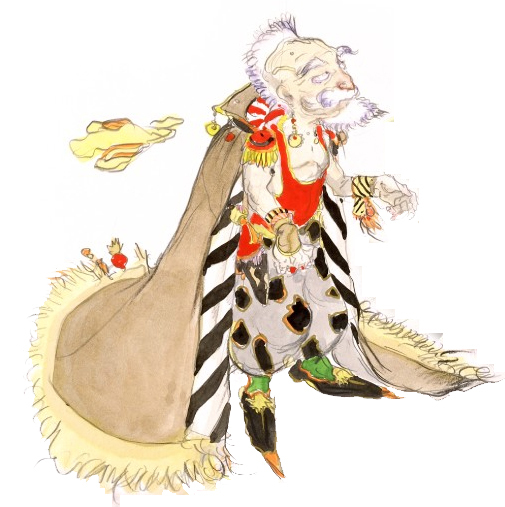
Strago (Stragus in the Japanese version) is an old wizard living in the village of Thamasa. His special ability is Lore. He can learn attacks from enemies that the party has fought before, and then use them in battle. Not every spell can be learned in Lore, however. Strago is a descendant of the Mage Warriors, hence his natural magic abilities. His ancestors fought in the War of the Magi. Apparently, Relm is not Strago's actual granddaughter, but a 'friend's daughter.' It is hinted at during Shadow's flashbacks that he is the actual father of Relm.
After talking to Strago in Thamasa, everyone in the town becomes more friendly. The innkeeper lowers the price to sleep there from 1000GP to 1GP. Despite Strago denying any connection to magic or the Espers, it is eventually revealed that he indeed can use magic and has a knowledge of Espers. During the night, he asks the party to save his granddaughter, Relm, from a burning building. After rescuing her, Strago will join the party, and eventually Relm will as well.
In the World of Ruin, Strago is first found in the Cult of Kefka. If Relm is in the party, however, he snaps out of his trance, and joins the party. Upon returning to Thamasa, one of Strago's friends fakes and injury and claims that it came from the beast Hidon, a monster that Strago spent almost his entire life chasing. His curiosity renewed, he goes to search again. After finding and defeated Hidon, Strago is the happiest he's ever been, and Relm thanks his friend for it.
Relm Arrowny
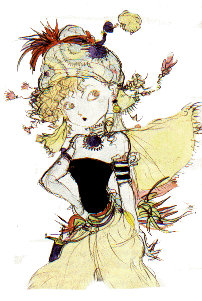
Relm is a ten year old (although she is much smarter than an average ten year old) from Thamasa. She is an incredible artist, causing her special ability to be Sketch, in which she paints a picture of the enemy that the attack is used on, and then using its own attack back on it. If the Relic Fake Mustache is attached to Relm, Sketch is replaced with Control, which allows the player to control the enemy that the attack is used on. It is hinted throughout the game that Shadow is Relm's actual father.
After Strago joins the player's party, Relm feels left out and follows the party into the Esper Cave. She helps out by sketching Ultros, and showing him that he actually is an ugly octopus. During the World of Ruin Relm can be found in one of two places. She can be found in the Cave in the Veldt if Shadow wasn't rescued, or she can be found in the mansion of Owzer, where she is being forced to paint. The painting she is making is possessed by a demon, and the party has to defeat it to get Relm back in the party.
Setzer Gabbiani
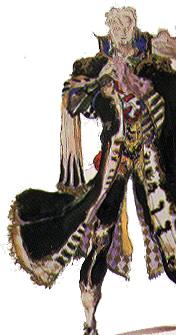
Setzer is an infamous gambler who appears to be an enemy character at first, but then turns out to be benign. His special attack is Slot, in which Setzer uses a slot machine to choose from a variety of attacks. If the Relic Coin Toss is equipped to him, Slot is replaced with GP Rain, in which he throws coins at the enemies.
When Setzer is first introduced, he announces that he plans to kidnap Maria, an opera singer who is going to star in the performance "The Dream Oath: Maria and the Draco." Celes then agrees to impersonate Maria, since she is her exact double. After being captured by Setzer, she bets her hand in marriage in trade for the use of Setzer's airship, the Blackjack. She uses the same double-sided coin that Edgar used to lose to his brother. Amused that he was beaten at his own game, Setzer joins the party and agrees to help the Returners.
In the World of Ruin, the Blackjack has been destroyed. Depressed, Setzer is found in a cafe. The party convinces him to join by showing their hope that the world will go back to normal. Setzer then uncovers the location of the Falcon, the only other airship in the world that belonged to his deceased friend Daryl.
Gau
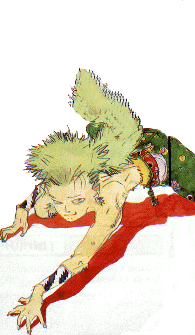
Gau is a unique character that is found living among the animals in the Veldt. His special ability is a combination of two commands: Leap and Rage. After leaping, he will learn a skill from the monster that is being fought. By using Rage, a monster can be selected, and its attack will be used. Leap can only be used in the Veldt, but Rage can be used anywhere. Gau's father is an insane old man living by the Lethe River. Gau's mother died, and Gau's father thought that Gau was possessed by demons, so he left the baby in the Veldt.
Gau is first found living in the Veldt. After encountering him, Gau takes a liking to Cyan (and makes fun of his old English accent). To gain his trust, he must be fed Dried Meat. Gau guides the party to a helmet that can be used to breath underwater.
In the World of Ruin, Gau can again be found in the Veldt, but only three or less characters can be in the party.
Mog
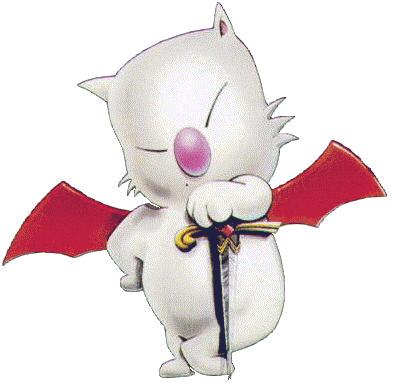
Mog is a moogle who, unlike other moogles, can speak English. He lives in the caves of Narshe along with the rest of the moogles. His special ability is Dance, which changes the background and uses one of four attacks randomly. Mog is somewhat like the "mascot" of the game, as he appears on most of the merchandise in relation to the game.
Mog is first seen when he helps Locke fight off the Narshe Guard while Locke escapes with Terra. When Mog joins the party, he is kidnapped by a mercenary named Lone Wolf, who gives the player a choice between a treasure that Lone Wolf offers, or Mog. Mog can be found in the Caves of Narshe in the World of Ruin.
While Mog is the only moogle that can join the party on a permanent basis, many of his moogle friends are playable in battle during an early part of the game.
Optional/Secret Characters
Gogo
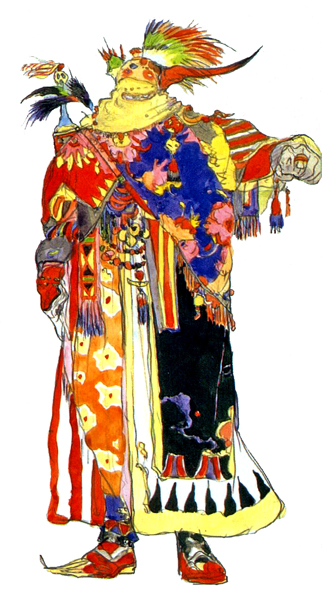
Gogo is a mysterious person whose gender is unknown. Gogo is completely hidden from view by the brightly colored clothes that Gogo wears. Gogo's special (and only) ability is Mimic, in which Gogo uses the same attack that the previous character used.
Gogo can only be found in the belly of a monster called the Zone Eater in the World of Ruin. After making it all the way to Gogo, Gogo finds the party worthy and agrees to join.
Umaro
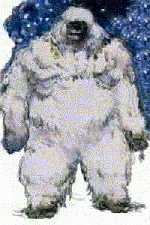
Umaro is a yeti who resides in the mines of Narshe. Like Gogo, Umaro is completely optional. Umaro always has the status of Berserk, so he can't be controlled by the player. He can't be equipped with any items besides Relics. Umaro's only attack (unless Relics are attached) is a powerful physical attack.
Umaro is found in the mines of Narshe in the World of Ruin when Mog recommends that they should seek his aid. Once Umaro is found, he must be fought, and the Mog will reprimand him for attacking the party and demand that he joins the party.
Other Notable Characters
In addition to the aforementioned playable characters, many other important characters play integral roles throughout the game. These non-playable characters (NPCs) are essential to the story's progression, and the game in a whole. The characters below are the most important, story-wise, to the game.
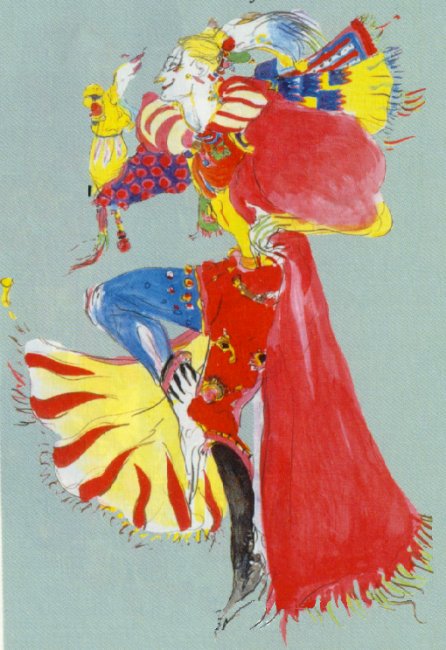
Kefka (he is Cefca Palazzo in the Japanese version) is the main antagonist of the game. One of the most notorious of all the Final Fantasy villains; he isn't a living incarnation of sin, or a supreme god-like being come to plunge the world into utter darkness. He is just an evil, evil man; one part coward, one part clown, one part mage, and one part nihilistic megalomaniac bent on world domination. His infamous cackle is one of the first things verbally spoken in a Final Fantasy game.
Kefka was born and immediately abandoned. He was raised in a Thamasa orphanage in which he was beaten often by the orphanage head. He developed a cold, quiet personality due to his early experiences. Kefka eventually migrated to Vector and entered the Imperial academy where he graduated at the top of his class. Cid immediately recognized his talents and took him on as an apprentice, putting him in prime position to be the first volunteer for the Magitek Knight program. He was genetically fused with magic through an imperfect program, but for years showed no signs of it affecting his sanity whatsoever.
He went on to become incredibly successful within the Empire, taking command of the Magitek Knights at only 23 years of age. It was then that he met Celes Chere, an orphaned citizen of Tzen, and took a liking to her. Celes became his apprentice and he pulled several strings to ensure that she became a Magitek Knight herself. Kefka's imperial career peaked at age 31 when he was made Imperial Prime Minister, a position second only to Emperor Gestahl himself. Kefka gained fame as a brilliant tactician and strategic savant. It was at this time that Kefka's sanity began to deteriorate, most likely due to imperfections in the original magic-infusing process he underwent from Cid.
At a banquet celebrating Celes' promotion to Rear Admiral, Kefka finally cracked with a violent outburst, and slid quickly into insanity afterward. Once shy and taciturn, Kefka began dressing in garish clown costumes and wearing makeup. Memories of his teenage and adult life began to fade away, leaving only his horrid childhood. Thus he became more cruel and more hateful and eventually developed a bloodlust and an obsession with destruction. Gestahl noticed this and removed him from the military.
However, Gestahl was still thankful to Kefka for his years of service beyond expectation and stellar military record, so Kefka was placed at the position of Court Mage. His former position was filled by General Leo, which sparked Kefka's intense jealousy and hatred of the man which culminates during the events of the game. Kefka's reputation among imperial soldiers is on display in the camp outside Doma castle during Sabin's scenario. He has a reputation as a coward, yet many of the imperial soldiers still fear him due to his being prone to wild fits of rage and violence.
Kefka is responsible for many of the game's events. He is the one who demands that a Slave Crown be put on Terra's head. He also is responsible for the poisoning of Doma's water supply; after General Leo takes too long to formulate an attack plan, Kefka decides to take matters into his own hands and poisons the water. He is also at the Magitek Research Facility, where he physically and mentally abuses Espers to suck them dry of their power. In a ploy later in the game, Emperor Gestahl puts Kefka in prison, claiming that his poisoning of Doma was unnecessary and cruel. After it is revealed to be an evil Imperial plot, Kefka comes to Thamasa where he turns the congregated Espers into Magicite.
Using that power, Kefka and Emperor Gestahl revive the Floating Continent, where statues that keep the world in balance reside. After the party reaches him, he freezes them all (except Celes) with power that he is getting from the statues. He then orders her to stab the party, and gives her a sword. Refusing, she stabs him instead. Kefka is annoyed and enraged, but not fatally wounded. He orders the statues to kill them all. Gestahl, afraid that Kefka is going to upset the gentle balance of the statues, shouts at him to stop. Kefka refuses, and then kills Gestahl and merely kicks his body off the edge of the Floating Continent. He then moves all of the statues around, reshaping the World of Balance into the World of Ruin.
In the World of Ruin, Kefka is technically the "god" of the land. He rules with an iron fist from atop his perch in Kefka's Tower. If so little as one person opposes him, he destroys their entire town with the "Light of Judgment." The effects of this are seen in several places, especially in Tzen and Mobliz. Followers of his have joined a cult called the Cult of Kefka. Members walk around mindlessly, and one villager says that there is no hope for them. However, Strago is seen with them, and he can be revived.
After reaching the top of Kefka's Tower, Kefka can't believe that the party can have so much hope in such a ruined world. They all use examples from their personal lives (and quests in the game). This angers Kefka, and he takes on his god form, which has several stages with multiple forms in each stage. After defeating him, the end of magic in the world is witnessed. Terra, being part Esper, was believed to be one of the casualties at first, but then she lands on the airship, alive and well.
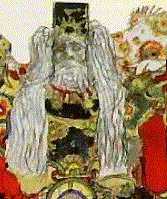
Gestahl (he is Gastra in the Japanese version) is the ruler of the Empire. Gestahl has ruled the Empire ever since its beginning, and is obsessed with harnessing magical energy for aid in his military conquest. He once managed to infiltrate the Esper home world, but was quickly ejected from it (along with Terra and her mother). When the Espers realize that he is attempting to come into their home again, they break free of the gate, and--being unable to control their power at first--they completely obliterate the capital city of Vector. Amazed at their power, the Empire lay down their arms, and Kefka is thrown in jail for his crimes. It is, however, merely a ploy to get into the Esper home world. General Leo, the most noble general of the Empire, is kept out of the secret, however, so when he tries to protect the Espers, he is killed by Kefka.
Gestahl underestimates Kefka's own insanity, and ends up being murdered when he tries to stop him. He is shamed by Kefka when his dead body is disrespectfully knocked off the Floating Continent.
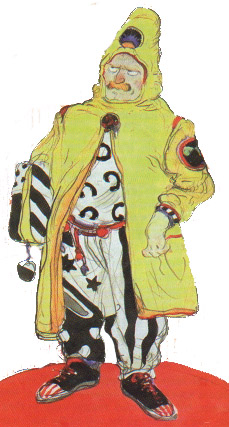
Cid is a recurring character in the Final Fantasy franchise. In this particular game, he is the head researcher of the Empire. His work led to several inventions, including Magitek Armor. He is referred to as a grandfather figure to Celes several times in the game, and when she joins the Returners, he begins having doubts about Emperor Gestahl and Kefka's plans. He helps the party by warning them about a trap in Vector and by helping them escape the Magitek Research Facility.
After the World of Balance is destroyed, Cid (and many others, including Celes) is stranded on a small island. It is subtly referenced that the others all committed suicide by jumping off a large cliff on the island (and Celes attempts to as well, once Cid dies). He cares for Celes for a year while she is in a coma, falling ill while he does so. Once Celes awakens, he dies, but not before revealing a raft that Celes can use to escape the island.
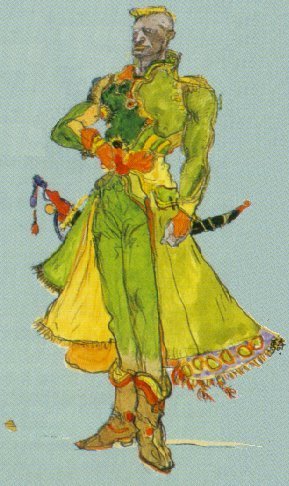
General Leo is one of the two head Imperial Generals (the other being Celes). Leo is more noble than other Imperial leaders, such as Kefka and Gestahl. He was assigned to capture Doma, but when he had to leave, Kefka took over and poisoned the water. He later apologizes to the only remaining survivor, Cyan. During the fake peace treaty between the Empire and the Returners, the fact that it isn't true is kept away from Leo. When the Espers meet to negotiate peace, he does the talking, and convinces them to have peace.
After Kefka reveals the plan as being fake, Leo bravely defends the Espers and the party. However, Kefka quickly destroys him using the powerful magic that he absorbed from the already dead Espers.
General Leo was subject to a famous rumor in the '90s. Much like Aerith Gainsborough of Final Fantasy VII, many fans claimed that there was indeed a way to bring Leo back from the demise he fell to at Kefka's hands. These were, however, proven incorrect as it is now confirmed that there is no way to bring back the fan favorite in the World of Ruin aside from altering the game's code.
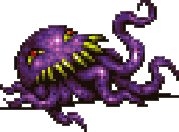
Ultros (he is Othros in the Japanese version) is a purple talking octopus who appears at many times during the game. He is a humorous boss character who seems to be a comic relief character. He has a friend named Chupon who is also fought occasionally.
In the World of Balance he is fought four times. He is first encountered on the Lethe River, where he spouts out many of the catchphrases he is famous for. In the World of Ruin, he ends up owing too much money to the owner of the Colosseum. He works as a receptionist for the Colosseum, and his friend Chupon works as a monster when no other monster will fight.
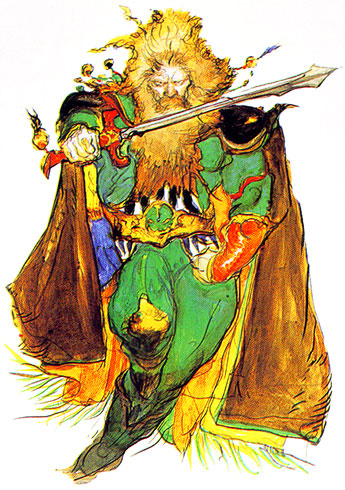
Banon (Bannan in the Japanese version) is the leader of the Returners, a rather large group of rebels who are determined to overthrow the corrupt Empire. He is playable for a small part of the game (when the party is on the Lethe River). His special ability is Health, which heals the entire party without using any magic points. After the destruction of the World of Balance, he is not encountered again.
Kefka

Kefka (he is Cefca Palazzo in the Japanese version) is the main antagonist of the game. One of the most notorious of all the Final Fantasy villains; he isn't a living incarnation of sin, or a supreme god-like being come to plunge the world into utter darkness. He is just an evil, evil man; one part coward, one part clown, one part mage, and one part nihilistic megalomaniac bent on world domination. His infamous cackle is one of the first things verbally spoken in a Final Fantasy game.
Kefka was born and immediately abandoned. He was raised in a Thamasa orphanage in which he was beaten often by the orphanage head. He developed a cold, quiet personality due to his early experiences. Kefka eventually migrated to Vector and entered the Imperial academy where he graduated at the top of his class. Cid immediately recognized his talents and took him on as an apprentice, putting him in prime position to be the first volunteer for the Magitek Knight program. He was genetically fused with magic through an imperfect program, but for years showed no signs of it affecting his sanity whatsoever.
He went on to become incredibly successful within the Empire, taking command of the Magitek Knights at only 23 years of age. It was then that he met Celes Chere, an orphaned citizen of Tzen, and took a liking to her. Celes became his apprentice and he pulled several strings to ensure that she became a Magitek Knight herself. Kefka's imperial career peaked at age 31 when he was made Imperial Prime Minister, a position second only to Emperor Gestahl himself. Kefka gained fame as a brilliant tactician and strategic savant. It was at this time that Kefka's sanity began to deteriorate, most likely due to imperfections in the original magic-infusing process he underwent from Cid.
At a banquet celebrating Celes' promotion to Rear Admiral, Kefka finally cracked with a violent outburst, and slid quickly into insanity afterward. Once shy and taciturn, Kefka began dressing in garish clown costumes and wearing makeup. Memories of his teenage and adult life began to fade away, leaving only his horrid childhood. Thus he became more cruel and more hateful and eventually developed a bloodlust and an obsession with destruction. Gestahl noticed this and removed him from the military.
However, Gestahl was still thankful to Kefka for his years of service beyond expectation and stellar military record, so Kefka was placed at the position of Court Mage. His former position was filled by General Leo, which sparked Kefka's intense jealousy and hatred of the man which culminates during the events of the game. Kefka's reputation among imperial soldiers is on display in the camp outside Doma castle during Sabin's scenario. He has a reputation as a coward, yet many of the imperial soldiers still fear him due to his being prone to wild fits of rage and violence.
Kefka is responsible for many of the game's events. He is the one who demands that a Slave Crown be put on Terra's head. He also is responsible for the poisoning of Doma's water supply; after General Leo takes too long to formulate an attack plan, Kefka decides to take matters into his own hands and poisons the water. He is also at the Magitek Research Facility, where he physically and mentally abuses Espers to suck them dry of their power. In a ploy later in the game, Emperor Gestahl puts Kefka in prison, claiming that his poisoning of Doma was unnecessary and cruel. After it is revealed to be an evil Imperial plot, Kefka comes to Thamasa where he turns the congregated Espers into Magicite.
Using that power, Kefka and Emperor Gestahl revive the Floating Continent, where statues that keep the world in balance reside. After the party reaches him, he freezes them all (except Celes) with power that he is getting from the statues. He then orders her to stab the party, and gives her a sword. Refusing, she stabs him instead. Kefka is annoyed and enraged, but not fatally wounded. He orders the statues to kill them all. Gestahl, afraid that Kefka is going to upset the gentle balance of the statues, shouts at him to stop. Kefka refuses, and then kills Gestahl and merely kicks his body off the edge of the Floating Continent. He then moves all of the statues around, reshaping the World of Balance into the World of Ruin.
In the World of Ruin, Kefka is technically the "god" of the land. He rules with an iron fist from atop his perch in Kefka's Tower. If so little as one person opposes him, he destroys their entire town with the "Light of Judgment." The effects of this are seen in several places, especially in Tzen and Mobliz. Followers of his have joined a cult called the Cult of Kefka. Members walk around mindlessly, and one villager says that there is no hope for them. However, Strago is seen with them, and he can be revived.
After reaching the top of Kefka's Tower, Kefka can't believe that the party can have so much hope in such a ruined world. They all use examples from their personal lives (and quests in the game). This angers Kefka, and he takes on his god form, which has several stages with multiple forms in each stage. After defeating him, the end of magic in the world is witnessed. Terra, being part Esper, was believed to be one of the casualties at first, but then she lands on the airship, alive and well.
Emperor Gestahl

Gestahl (he is Gastra in the Japanese version) is the ruler of the Empire. Gestahl has ruled the Empire ever since its beginning, and is obsessed with harnessing magical energy for aid in his military conquest. He once managed to infiltrate the Esper home world, but was quickly ejected from it (along with Terra and her mother). When the Espers realize that he is attempting to come into their home again, they break free of the gate, and--being unable to control their power at first--they completely obliterate the capital city of Vector. Amazed at their power, the Empire lay down their arms, and Kefka is thrown in jail for his crimes. It is, however, merely a ploy to get into the Esper home world. General Leo, the most noble general of the Empire, is kept out of the secret, however, so when he tries to protect the Espers, he is killed by Kefka.
Gestahl underestimates Kefka's own insanity, and ends up being murdered when he tries to stop him. He is shamed by Kefka when his dead body is disrespectfully knocked off the Floating Continent.
Cid Del Norte Marguez

Cid is a recurring character in the Final Fantasy franchise. In this particular game, he is the head researcher of the Empire. His work led to several inventions, including Magitek Armor. He is referred to as a grandfather figure to Celes several times in the game, and when she joins the Returners, he begins having doubts about Emperor Gestahl and Kefka's plans. He helps the party by warning them about a trap in Vector and by helping them escape the Magitek Research Facility.
After the World of Balance is destroyed, Cid (and many others, including Celes) is stranded on a small island. It is subtly referenced that the others all committed suicide by jumping off a large cliff on the island (and Celes attempts to as well, once Cid dies). He cares for Celes for a year while she is in a coma, falling ill while he does so. Once Celes awakens, he dies, but not before revealing a raft that Celes can use to escape the island.
General Leo Sharret Cristophe

General Leo is one of the two head Imperial Generals (the other being Celes). Leo is more noble than other Imperial leaders, such as Kefka and Gestahl. He was assigned to capture Doma, but when he had to leave, Kefka took over and poisoned the water. He later apologizes to the only remaining survivor, Cyan. During the fake peace treaty between the Empire and the Returners, the fact that it isn't true is kept away from Leo. When the Espers meet to negotiate peace, he does the talking, and convinces them to have peace.
After Kefka reveals the plan as being fake, Leo bravely defends the Espers and the party. However, Kefka quickly destroys him using the powerful magic that he absorbed from the already dead Espers.
General Leo was subject to a famous rumor in the '90s. Much like Aerith Gainsborough of Final Fantasy VII, many fans claimed that there was indeed a way to bring Leo back from the demise he fell to at Kefka's hands. These were, however, proven incorrect as it is now confirmed that there is no way to bring back the fan favorite in the World of Ruin aside from altering the game's code.
Ultros

Ultros (he is Othros in the Japanese version) is a purple talking octopus who appears at many times during the game. He is a humorous boss character who seems to be a comic relief character. He has a friend named Chupon who is also fought occasionally.
In the World of Balance he is fought four times. He is first encountered on the Lethe River, where he spouts out many of the catchphrases he is famous for. In the World of Ruin, he ends up owing too much money to the owner of the Colosseum. He works as a receptionist for the Colosseum, and his friend Chupon works as a monster when no other monster will fight.
Banon

Banon (Bannan in the Japanese version) is the leader of the Returners, a rather large group of rebels who are determined to overthrow the corrupt Empire. He is playable for a small part of the game (when the party is on the Lethe River). His special ability is Health, which heals the entire party without using any magic points. After the destruction of the World of Balance, he is not encountered again.
Soundtrack
The music of Final Fantasy VI was written by Nobuo Uematsu, who was well-known for his work in previous Final Fantasy games. He composed a theme song for every playable character. In addition to these themes, the soundtrack contains a traditional battle theme, multiple boss fight themes, songs for special events, and songs for several of the towns and other locales. A few tracks exceed ten minutes; these include "Dancing Mad", the seventeen minute-long final boss theme, and the "Ending Theme", which combines all of the individual character theme songs.
One of the game's most famous songs is "Aria di Mezzo Carattere", a song that is played during the well-known opera scene. The sound chip of the SNES (SPC700 format sound chip) didn't allow for actual voice, so Uematsu created a synthesized voice that sang in rhythm to the song. Later in the SNES' life, some developers figured out how to do actual voice, however. In Final Fantasy VI Grand Finale, "Aria di Mezzo Carattere" is sung in Italian by Svetla Krasteva.
There were many albums of Final Fantasy VI's music released. The original soundtrack was released on three discs in both North America (as Final Fantasy III: Kefka's Domain) and Japan (as Final Fantasy VI: Original Sound Version). Final Fantasy VI Grand Finale was an album that contained orchestral arrangements of Final Fantasy VI's music. Piano Collections: Final Fantasy VI featured music from the game preformed on piano by Reiko Nomura. Final Fantasy VI Special Tracks was an album that consisted of unused songs or remixed music. In addition, many of Final Fantasy VI's songs have been adapted by other bands (such as Nobuo Uematsu's own band The Black Mages, and the band Machinae Supremacy).

Final Fantasy VI: Original Sound Version
One of the game's most famous songs is "Aria di Mezzo Carattere", a song that is played during the well-known opera scene. The sound chip of the SNES (SPC700 format sound chip) didn't allow for actual voice, so Uematsu created a synthesized voice that sang in rhythm to the song. Later in the SNES' life, some developers figured out how to do actual voice, however. In Final Fantasy VI Grand Finale, "Aria di Mezzo Carattere" is sung in Italian by Svetla Krasteva.
There were many albums of Final Fantasy VI's music released. The original soundtrack was released on three discs in both North America (as Final Fantasy III: Kefka's Domain) and Japan (as Final Fantasy VI: Original Sound Version). Final Fantasy VI Grand Finale was an album that contained orchestral arrangements of Final Fantasy VI's music. Piano Collections: Final Fantasy VI featured music from the game preformed on piano by Reiko Nomura. Final Fantasy VI Special Tracks was an album that consisted of unused songs or remixed music. In addition, many of Final Fantasy VI's songs have been adapted by other bands (such as Nobuo Uematsu's own band The Black Mages, and the band Machinae Supremacy).
Final Fantasy VI: Original Sound Version

Final Fantasy VI: Original Sound Version
- Omen (4:15)
- The Mines of Narshe (2:48)
- Awakening (1:41)
- Locke's Theme (2:01)
- Battle (1:59)
- Victory Fanfare (0:39)
- Edgar and Sabin's Theme (2:32)
- Kefka (2:43)
- Mt. Koltz (2:30)
- The Returners (2:42)
- Shadow's Theme (1:53)
- Troops March On (1:56)
- Cyan's Theme (2:21)
- The Unforgiven (1:23)
- Phantom Forest (3:17)
- Phantom Train (2:49)
- The Veldt (2:17)
- Gau's Theme (1:50)
- The Serpent Trench (2:06)
- Kids Run Through the City (2:42)
- Under Martial Law (2:26)
- Celes's Theme (2:56)
- Protect the Espers! (1:57)
- The Decisive Battle (2:01)
- Metamorphosis (1:25)
- Terra's Theme (3:50)
- Coin of Fate (3:14)
- Techno de Chocobo (1:35)
- Forever Rachel (2:51)
- Slam Shuffle (2:20)
- Spinach Rag (2:13)
- Overture (4:46)
- Aria di Mezzo Carattere (3:55)
- Wedding Waltz ~ Duel (4:00)
- Grand Finale (3:14)
- Setzer's Theme (1:55)
- Johnny C. Bad (2:54)
- The Gestahl Empire (3:11)
- Magitek Research Facility (2:32)
- The Airship Blackjack (3:04)
- What? (1:07)
- Mog's Theme (1:54)
- Strago's Theme (2:29)
- Relm's Theme (2:54)
- Esper World (2:37)
- Floating Continent (2:27)
- Catastrophe (2:15)
- Battle to the Death (2:34)
- Rest in Peace (0:29)
- Dark World (3:03)
- From That Day On... (2:14)
- Searching for Friends (2:56)
- Gogo's Theme (2:10)
- Epitaph (2:50)
- The Magic House (2:32)
- Umaro's Theme (1:54)
- The Fanatics (1:47)
- Kefka's Tower (2:49)
- Dancing Mad (17:35)
- Balance is Restored (21:29)
- The Prelude (2:21)
This page has been seen 759 times.
-
-
Created by on
-

